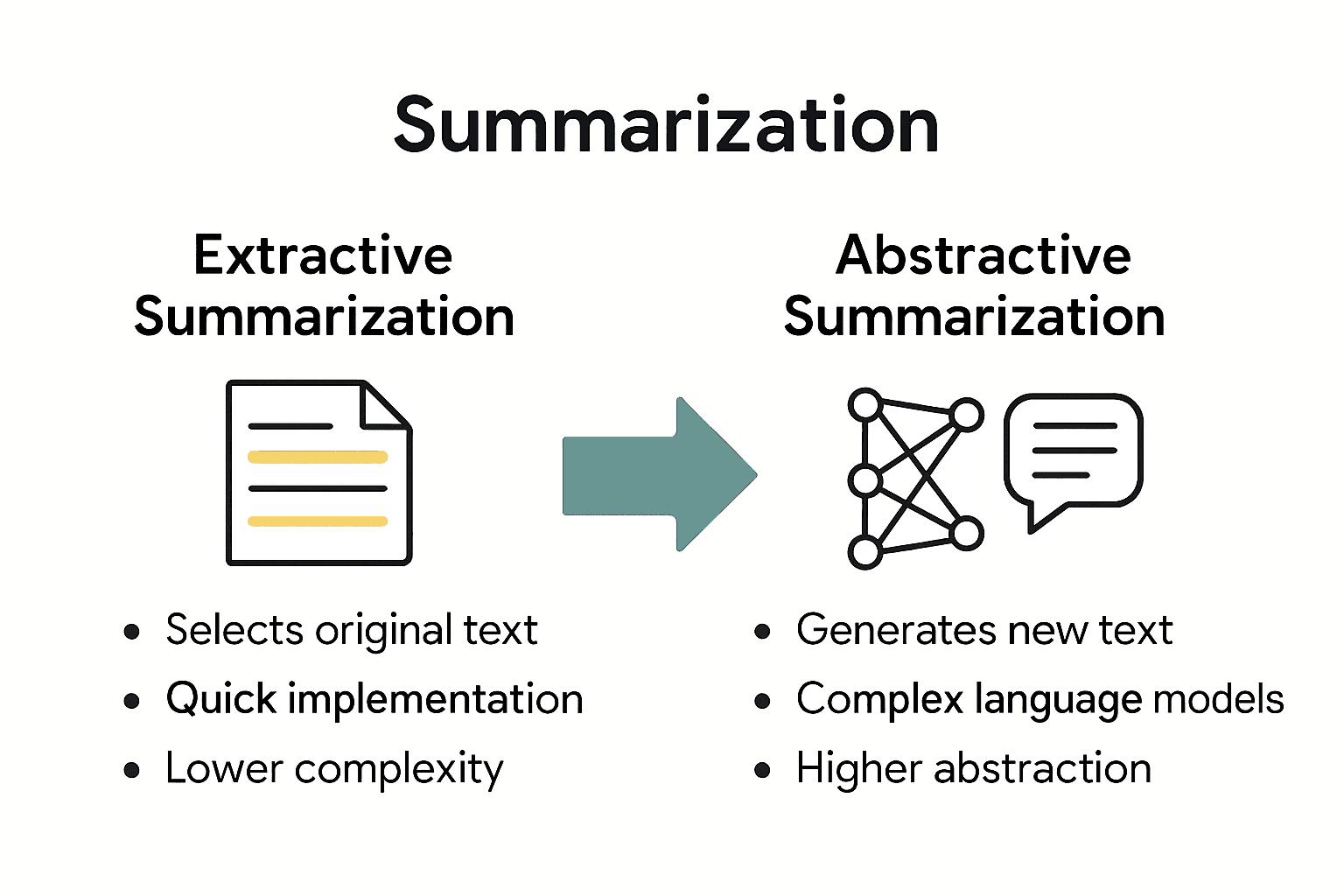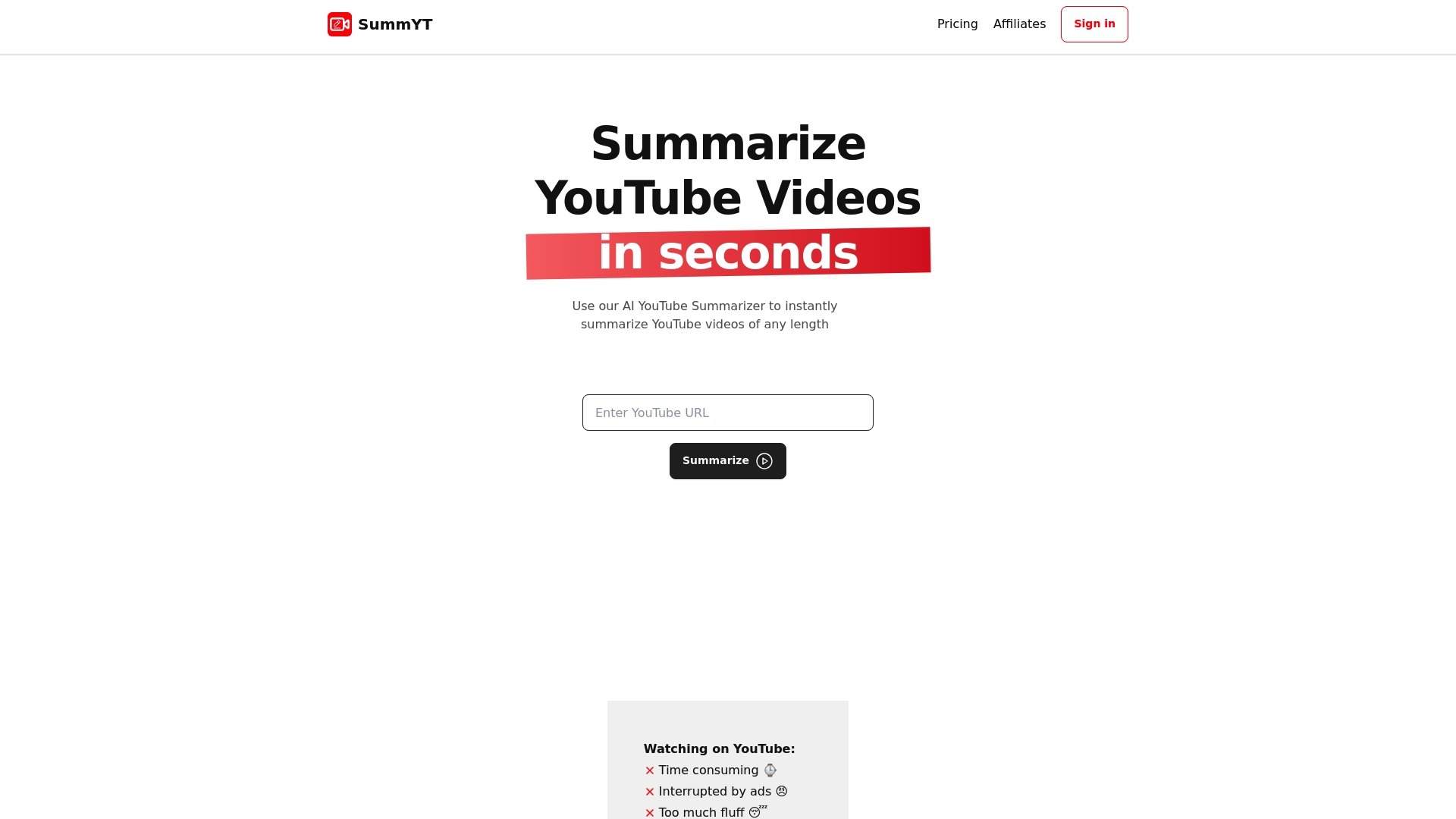Benefits of Content Summarizers: Complete Guide

Studies show that people spend nearly 30 hours each week sifting through written and digital content. With so much information to process, finding smarter ways to learn and work has become a priority for students, professionals, and content creators. Content summarizers promise a solution by turning long articles, research papers, and videos into clear, quick highlights. Understanding these tools can help anyone manage knowledge more efficiently and avoid getting lost in endless details.
Key Takeaways
| Point | Details |
|---|---|
| Content Summarizers’ Purpose | These tools condense complex information into concise insights, aiding information consumption in various formats like text, video, and podcasts. |
| Summarization Techniques | The primary approaches are extractive, which uses original sentences, and abstractive, which generates new content using advanced language models. |
| Use Cases Across Domains | Content summarizers benefit academic, corporate, and media professionals by enhancing productivity and facilitating quick information processing. |
| Limitations and Risks | Users must recognize that summarizers can misinterpret context, and summaries should not replace thorough understanding of original content. |
Table of Contents
- Defining Content Summarizers And Core Concepts
- Major Types And Key Functionalities Explained
- Leading Use Cases For Different Audiences
- Maximizing Productivity And Learning Efficiency
- Limitations, Risks, And Common Misconceptions
Defining Content Summarizers and Core Concepts
Content summarizers are intelligent tools that transform lengthy information into concise, digestible snippets. According to Wikipedia’s research on automatic summarization, these technologies computationally reduce data to represent the most critical information across various formats.
At their core, content summarizers operate through two primary methodological approaches:
- Extractive Summarization: Selects and preserves original sentences that best capture the source material’s core meaning
- Abstractive Summarization: Generates entirely new text that captures the essential insights, often using advanced natural language processing techniques
These tools aren’t limited to text. Modern summarization technologies can process multiple content types, including:
- Textual documents
- Video lectures
- Podcast transcripts
- Web articles
- Research papers
The fundamental goal remains consistent: transform complex, time-consuming content into quick, comprehensible knowledge nuggets. Read more about different types of content summaries to understand how these technologies are revolutionizing information consumption across professional and academic domains.
Major Types and Key Functionalities Explained
Content summarization techniques represent sophisticated approaches to distilling complex information. According to GeeksforGeeks’ research on text summarization techniques, these methods primarily fall into two advanced categories: extractive and abstractive summarization, each leveraging unique computational strategies.
Extractive Summarization Techniques
In extractive summarization, algorithms identify and select the most representative sentences from the original content. These methods use:
- Statistical analysis
- Graph-based ranking algorithms
- Machine learning models
The core objective is preserving the original text’s exact wording while creating a condensed version that captures the primary message.
Abstractive Summarization Techniques
Abstractive summarization represents a more advanced approach. Unlike extractive methods, these techniques:
- Interpret the entire content semantically
- Generate entirely new sentences
- Use complex neural network architectures like:
- Sequence-to-sequence models
- Attention mechanisms
- Pre-trained transformer architectures
Learn more about real-time content summarization strategies to understand how these cutting-edge technologies are transforming information processing across various domains.
Here’s a comparison of extractive and abstractive summarization techniques:
| Aspect | Extractive Summarization | Abstractive Summarization |
|---|---|---|
| Approach | Selects original sentences | Generates new sentences |
| Techniques Used | Statistical analysis Graph-based ranking ML models |
Neural networks Seq2Seq models Attention mechanisms |
| Output Style | Copy from source | Paraphrased, reworded |
| Complexity | Lower | Higher |
| Strength | Preserves precise meaning | Offers concise, original insights |
| Limitation | Lacks abstraction | May miss subtle context |

|
Leading Use Cases for Different Audiences
Content summarizers deliver transformative value across diverse professional and academic landscapes, empowering individuals to process information more efficiently. These intelligent tools adapt seamlessly to specific user needs, providing targeted solutions that dramatically reduce time spent consuming complex content.
Academic and Research Professionals
For students and researchers, content summarizers become critical research companions. They can:
- Rapidly analyze academic papers
- Extract key research insights
- Compare multiple scholarly sources quickly
- Prepare literature review materials
- Generate concise research notes
Corporate and Professional Settings
Business professionals leverage summarization technologies to streamline information management. Typical applications include:
- Condensing lengthy market reports
- Summarizing complex industry white papers
- Creating executive briefings
- Monitoring competitive intelligence
- Preparing quick reference documents
Media and Content Creation
Journalists, writers, and content creators use summarization tools to:
- Research topics efficiently
- Generate quick article outlines
- Identify trending themes
- Cross-reference multiple source materials
Explore seven essential examples of content summarizers to understand how these technologies are revolutionizing information consumption across different professional domains.
Maximizing Productivity and Learning Efficiency
Content summarizers transform how we absorb and process information, turning overwhelming data streams into manageable, actionable knowledge. By condensing complex materials into precise, digestible insights, these tools become powerful productivity accelerators across personal and professional domains.
Time Management Strategies
Effective use of content summarizers can dramatically reduce information consumption time. Key productivity benefits include:
- Cutting research time by up to 70%
- Enabling faster decision-making
- Reducing cognitive load
- Helping prioritize critical information
- Minimizing unnecessary content exploration
Learning Acceleration Techniques
Beyond time savings, content summarizers fundamentally enhance learning processes. They help learners:
- Focus on core conceptual understanding
- Quickly grasp complex subject matter
- Create structured review materials
- Develop more efficient study habits
- Retain information more effectively
Cognitive Optimization
By presenting information in concise, structured formats, these tools support cognitive efficiency. They help users bypass information overload, enabling more strategic knowledge acquisition and deeper comprehension.
Discover how summaries can transform your learning approach and unlock your full potential for rapid, effective information processing.
Limitations, Risks, and Common Misconceptions
Content summarizers are powerful tools, but they are not magical solutions that can replace comprehensive understanding. Like any technology, they come with specific limitations and potential risks that users must carefully navigate and understand.
Technical Limitations
Content summarization technologies face several inherent challenges:
- Difficulty capturing nuanced context
- Potential loss of critical subtle details
- Varying accuracy across different content types
- Challenges with highly technical or specialized materials
- Potential semantic misinterpretations
Common Misconceptions
Many users harbor unrealistic expectations about content summarization technologies:
- Believing summaries are 100% accurate replacements for original content
- Assuming all summarization tools work identically
- Thinking summaries eliminate the need for deep reading
- Expecting perfect comprehension from abbreviated content
- Overlooking the importance of human critical thinking
Risk Mitigation Strategies
To maximize the value of content summarizers while minimizing risks, users should:
- Always cross-reference summaries with original sources
- Use multiple summarization tools for verification
- Develop critical thinking skills alongside technology use
- Understand the limitations of automated summarization
- Treat summaries as supplementary, not definitive, information
Learn more about efficient note-taking strategies to complement your content summarization approach and enhance overall information processing skills.
Turn Long YouTube Videos Into Powerful Summaries Instantly
Do you often feel overwhelmed by endless YouTube lectures, interviews, or webinars that take up your valuable time? The article explained how content summarizers transform complicated material into clear, bite-sized insights, giving you back control over your learning and productivity. If you want the benefits of extractive and abstractive summarization—but applied directly to videos—SummYT is your next essential tool.

Experience for yourself how SummYT uses advanced summarization techniques to deliver concise key points from any YouTube video in minutes. This saves you time, helps you learn faster, and lets you skip the fluff. Whether you are a student searching for quick study guides, a professional who needs efficient briefings, or a lifelong learner clearing out your “watch later” list, SummYT is designed for you.
Ready to work smarter and process information faster? Start turning videos into actionable knowledge today—visit SummYT and discover how easy it is to boost your productivity. For ideas on how summaries can power your learning, check out this guide to how summaries aid learning, or see real-time content summarization strategies to maximize your results right now.
Frequently Asked Questions
What are content summarizers and how do they work?
Content summarizers are intelligent tools that transform lengthy information into concise, digestible snippets. They operate through two main approaches: extractive summarization, which selects original sentences from the source material, and abstractive summarization, which generates new text representing the core ideas.
What types of content can be summarized using content summarizers?
Content summarizers can process various types of content, including textual documents, video lectures, podcast transcripts, web articles, and research papers. Their primary goal is to condense complex information into easily understandable summaries.
What are the key differences between extractive and abstractive summarization techniques?
Extractive summarization selects original sentences to maintain the original wording, while abstractive summarization generates new sentences that paraphrase and reword the source material. Extractive methods focus on preserving meaning with lower complexity, whereas abstractive methods offer more concise insights but are more complex.
How can content summarizers enhance productivity and learning efficiency?
Content summarizers can significantly reduce information consumption time, streamline research processes, and help users prioritize critical information. They also enhance learning by providing structured materials, aiding in grasping complex subjects, and optimizing cognitive efficiency.

Recommended
- 7 Essential Examples of Content Summarizers for 2025
- 7 Types of Content Summaries You Need to Know
- Understanding Summarization for Newsrooms
- 7 Essential Examples of Content Summarizers for 2025
- 7 Content Curation Strategies Every Business Owner Needs
- 7 Content Curation Strategies Every Business Owner Needs – My Blog



